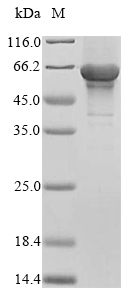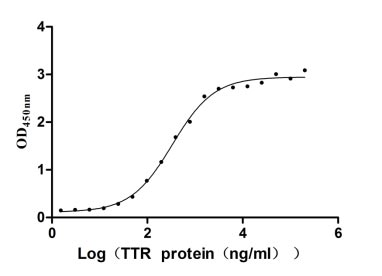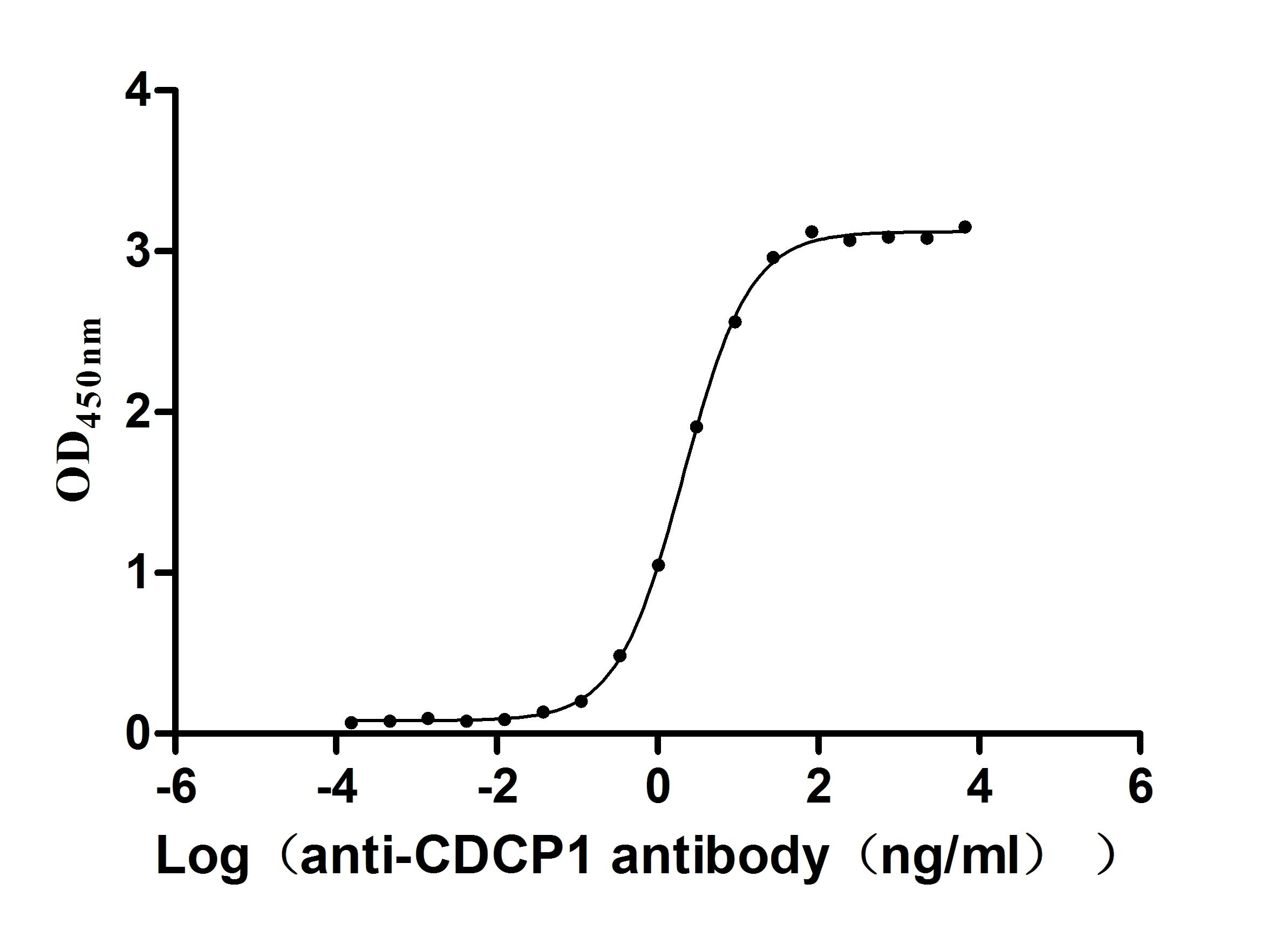Recombinant Human Transcriptional enhancer factor TEF-3 (TEAD4), partial
In Stock-
货号:CSB-EP618010HUe0
-
规格:¥1344
-
图片:
-
其他:
产品详情
-
纯度:Greater than 85% as determined by SDS-PAGE.
-
基因名:
-
Uniprot No.:
-
别名:EFTR 2; EFTR2; hRTEF 1B; hRTEF1B; MGC9014; OTTHUMP00000238119; OTTHUMP00000238122; OTTHUMP00000238124; Related to TEF 1; Related to TEF1; Related transcription enhancer factor 1B; RTEF1; TCF13L1; TEA domain family member 4; TEAD 4; TEAD-4; TEAD4; TEAD4_HUMAN; TEF 3; TEF3; TEFR 1; TEFR1; Transcription factor 13 (SV40 transcriptional enhancer factor) like 1; Transcription factor 13 like 1; Transcription factor 13-like 1; Transcription factor RTEF 1; Transcription factor RTEF-1; Transcription factor RTEF1; Transcriptional enhancer factor 1 related; Transcriptional enhancer factor 3; Transcriptional enhancer factor TEF 3; Transcriptional enhancer factor TEF-3; Transcriptional enhancer factor TEF3
-
种属:Homo sapiens (Human)
-
蛋白长度:Partial
-
来源:E.coli
-
分子量:67.3 kDa
-
表达区域:74-434aa
-
氨基酸序列MYGRNELIARYIKLRTGKTRTRKQVSSHIQVLARRKAREIQAKLKDQAAKDKALQSMAAMSSAQIISATAFHSSMALARGPGRPAVSGFWQGALPGQAGTSHDVKPFSQQTYAVQPPLPLPGFESPAGPAPSPSAPPAPPWQGRSVASSKLWMLEFSAFLEQQQDPDTYNKHLFVHIGQSSPSYSDPYLEAVDIRQIYDKFPEKKGGLKDLFERGPSNAFFLVKFWADLNTNIEDEGSSFYGVSSQYESPENMIITCSTKVCSFGKQVVEKVETEYARYENGHYSYRIHRSPLCEYMINFIHKLKHLPEKYMMNSVLENFTILQVVTNRDTQETLLCIAYVFEVSASEHGAQHHIYRLVKE
Note: The complete sequence including tag sequence, target protein sequence and linker sequence could be provided upon request. -
蛋白标签:N-terminal GST-tagged
-
产品提供形式:Liquid or Lyophilized powder
Note: We will preferentially ship the format that we have in stock, however, if you have any special requirement for the format, please remark your requirement when placing the order, we will prepare according to your demand. -
缓冲液:Tris-based buffer,50% glycerol
-
储存条件:Store at -20°C/-80°C upon receipt, aliquoting is necessary for mutiple use. Avoid repeated freeze-thaw cycles.
-
保质期:The shelf life is related to many factors, storage state, buffer ingredients, storage temperature and the stability of the protein itself.
Generally, the shelf life of liquid form is 6 months at -20°C/-80°C. The shelf life of lyophilized form is 12 months at -20°C/-80°C. -
货期:3-7 business days
-
注意事项:Repeated freezing and thawing is not recommended. Store working aliquots at 4°C for up to one week.
-
Datasheet & COA:Please contact us to get it.
相关产品
靶点详情
-
功能:Transcription factor which plays a key role in the Hippo signaling pathway, a pathway involved in organ size control and tumor suppression by restricting proliferation and promoting apoptosis. The core of this pathway is composed of a kinase cascade wherein MST1/MST2, in complex with its regulatory protein SAV1, phosphorylates and activates LATS1/2 in complex with its regulatory protein MOB1, which in turn phosphorylates and inactivates YAP1 oncoprotein and WWTR1/TAZ. Acts by mediating gene expression of YAP1 and WWTR1/TAZ, thereby regulating cell proliferation, migration and epithelial mesenchymal transition (EMT) induction. Binds specifically and non-cooperatively to the Sph and GT-IIC 'enhansons' (5'-GTGGAATGT-3') and activates transcription. Binds to the M-CAT motif.
-
基因功能参考文献:
- TEAD4, the transcription factor that mediates Hippo-YAP signalling, undergoes alternative splicing facilitated by the tumour suppressor RBM4. PMID: 27291620
- Combining single site-directed mutagenesis and double mutant analyses, the s conduct a detailed analysis on the role of several residues located at the YAP:TEAD interface. The results provide quantitative understanding of the interactions taking place at the YAP:TEAD interface and give insights into the formation of the YAP:TEAD complex and more particularly on the interaction between TEAD and the ohm-loop found ... PMID: 28430104
- Studied the effect of TEAD4 acylation on its interaction with YAP and TAZ; found YAP and TAZ bind in a similar manner to both acylated and non-acylated TEAD4. Also found TEAD4 acylation significantly enhances its stability. PMID: 28960584
- High TEF3 expression is associated with cell cycle progression and angiogenesis in colon cancer. PMID: 26885617
- Osmotic stress promotes TEAD4 cytoplasmic translocation via p38 MAPK in a Hippo-independent manner. Stress-induced TEAD inhibition predominates YAP-activating signals and selectively suppresses YAP-driven cancer cell growth. PMID: 28752853
- The transcription factor TEAD4 regulates a pro-metastasis transcription program in a YAP-independent manner in CRC, thus providing a novel mechanism of TEAD4 transcriptional regulation and its oncogenic role in CRC, independently of the Hippo pathway. PMID: 26387538
- our work provides a structural basis for understanding the regulatory mechanism of TEAD4-mediated gene transcription PMID: 28368398
- Our results suggest that TEAD4 plays a role in the pathophysiology of atypical teratoid/rhabdoid tumor, which represents a new insight into the biology of this aggressive tumor PMID: 27966820
- It was found that the TEAD4-YAP complex in the nuclei may be related closely to transcriptions of G1 arrest-related genes. PMID: 28315328
- Tead4 cooperates with AP1 transcription factors to coordinate target gene transcription. PMID: 26832411
- TEAD4 and KLF5, in collaboration, promoted triple negative breast cancer cell proliferation and tumor growth in part by inhibiting p27 gene transcription PMID: 25970772
- potential anti-oxidation gene and can prevent H2O2-induced endothelial cell oxidative damage by activating Klotho PMID: 26041389
- TEAD4 overexpression induced p16 in HAoSMCs homozygous for the nonrisk coronary disease allele, but not for the risk allele. PMID: 26487755
- the peptides TEF3-11-66 and TEF3-1197-434 functioned as two independent activation domains, suggesting that N-terminal domain of TEF3-1 also has transcriptional activation capacity PMID: 25687649
- Edg-1 is a potential target gene of RTEF-1 and is involved in RTEF-1-induced angiogenesis in endothelial cells. PMID: 24520353
- the multilevel perturbations of TEAD4 at epigenetic, transcriptional and posttranslational levels may contribute to GC development. PMID: 24325916
- These data suggest that TFF3 and survivin expressions play a vital role in gastric cancer development, and these two proteins are important markers for prognosis in gastric cancer. PMID: 22996285
- convergent optimization of the YAP/TAZ TEAD binding site suggests that the similarity in the affinities of binding of YAP to TEAD and of TAZ to TEAD is important for Hippo pathway functionality. PMID: 23780915
- High TEAD4 expression is associated with Age-Related Macular Degeneration. PMID: 22761647
- These results show that RTEF-1-stimulated IGFBP-1 expression may be central to the mechanism by which RTEF-1 attenuates blood glucose levels. PMID: 22843786
- Blocking connexin 43 function inhibited RTEF-1-induced endothelial cell connections and aggregation PMID: 22652601
- RTEF-1 plays an important role in FGFR1- stimulated vasodilatation. PMID: 22433836
- RTEF-1 as a regulator of HIF-1alpha transcription PMID: 21540178
- the RTEF-1-driven increase of VEGF-B plays an important role in communication between the endothelium and myocardium PMID: 21169295
- TEF3, mainly its nuclear localization, is required for VEGF-A(165)-induced endothelial proliferation, migration, tube formation, and in vivo Matrigel angiogenesis. PMID: 21169383
- Constitutive activation of alpha1-adrenergic signaling through the RTEF-1 transcription factor results in chronic elevation of PP1beta expression and connexin dephosphorylation. This mechanism may underlie some defects in cardiac conduction. PMID: 15520314
- Novel RTEF-1 transcripts are present within human ocular vascular endothelial cells and mouse neural retina during normal and retinopathy of prematurity development, and alternatively spliced products are produced under hyperoxic and hypoxic conditions PMID: 17652751
- The gain of function studies indicated that TEA domain family member 4 activate NR5A1 gene expression. PMID: 18579725
- TEF3 mediates the expression of Down syndrome candidate region 1 isoform 1 (DSCR1-1L) in endothelial cells PMID: 18840614
- The paper described several reasons to designate the putative translation initiation codon as the leucine (TTG) codon, which is 7 codons upstream from the isoleucine (ATT) codon. PMID: 8921372
- The paper described that the ORF of TEF-3 initiates with an ATT codon encoding isoleucine. PMID: 8702974
显示更多
收起更多
-
亚细胞定位:Nucleus.
-
组织特异性:Preferentially expressed in skeletal muscle. Lower levels in pancreas, placenta, and heart.
-
数据库链接:
HGNC: 11717
OMIM: 601714
KEGG: hsa:7004
STRING: 9606.ENSP00000352926
UniGene: Hs.94865
Most popular with customers
-
Recombinant Human Transthyretin (TTR) (Active)
Express system: Mammalian cell
Species: Homo sapiens (Human)
-
Recombinant Human C-C chemokine receptor type 8 (CCR8)-VLPs (Active)
Express system: Mammalian cell
Species: Homo sapiens (Human)
-
Recombinant Human Alkaline phosphatase, germ cell type (ALPG) (Active)
Express system: Mammalian cell
Species: Homo sapiens (Human)
-
Recombinant Human C-type lectin domain family 4 member C (CLEC4C), partial (Active)
Express system: Mammalian cell
Species: Homo sapiens (Human)
-
Recombinant Human Interleukin-2 (IL2) (Active)
Express system: Mammalian cell
Species: Homo sapiens (Human)
-
Recombinant Macaca fascicularis CUB domain containing protein 1 (CDCP1), partial (Active)
Express system: Mammalian cell
Species: Macaca fascicularis (Crab-eating macaque) (Cynomolgus monkey)
-
Express system: Mammalian cell
Species: Homo sapiens (Human)




















